
29 minute read
More Power
from 2022-07-CCEC
Electric Co-ops Adding Solar + Storage Across Rural NC
Renewable energy resources will be added at 14 sites
North Carolina’s Electric Cooperatives are bringing new energy innovation to rural North Carolina by coupling utility-scale solar with battery energy storage at 14 locations. The new solar + storage resources will be interconnected to electric cooperative grids and support the cooperatives’ Brighter Future efforts — an initiative to support co-op consumer-members and communities by building a more resilient, efficient grid, while upholding affordability and pursuing a long-term sustainability goal.
“Delivering value to co-op consumermembers and communities is a cornerstone of our cooperative purpose, and solar is a growing resource for us,” said Amadou Fall, COO of North Carolina’s Electric Cooperatives. “Pairing solar with battery energy storage enables us to gain the most benefit from an intermittent resource, advancing grid resilience and supporting our goal of achieving net-zero emissions by 2050.”
“Solar energy is most abundant during the middle of the day. However, peak energy demand typically occurs in the late afternoon hours in the summer and the early morning during the winter,” said John Lemire, director of grid management for North Carolina’s Electric Cooperatives. “With hybrid solar and storage solutions, renewable solar energy is captured when it’s most abundant in large batteries. This energy can then be discharged exactly when it’s needed to efficiently support the grid.”
Cooperatives in North Carolina are working together to integrate innovative energy technologies like solar and storage at a deliberate pace to balance and uphold commitments to reliability, affordability and sustainability. Currently, electric cooperatives have approximately 500 megawatts (MW) of renewable, distributed energy and edge-of-grid resources integrated or pending integration into cooperative grids through their shared role as a “distribution operator.”
As a distribution operator, the state’s electric co-ops are coordinating thousands of distributed energy resources throughout the grid to optimize their performance and support an efficient and strategic grid evolution.
“While cooperative power is already very reliable, this cuttingedge capability enhances reliability even further for co-op members, as power now flows multi-directionally throughout the grid,” Fall said.
14
SOLAR + STORAGE SITES
more than
75,000
SOLAR PANELS more than
53MWh
OF ENERGY STORAGE
will generate more than 23 MW, or enough to power more than
23,000
HOMES
Six developments are already operational: ■ Two sites in Duplin County—Interconnected with Four County EMC ■ One site in Halifax County—Interconnected with Halifax EMC ■ Three sites in Randolph County—Interconnected with Randolph EMC
Eight more expected to be activated by the end of the year: ■ One site in Greene County—Interconnected with Pitt & Greene EMC ■ One site in Hyde County—Interconnected with Tideland EMC ■ Three sites in Northampton County—Interconnected with
Roanoke Electric Cooperative ■ One site in Richmond County—Interconnected with Pee Dee Electric ■ One site in Sampson County—Interconnected with South River EMC ■ One site in Wake County—Interconnected with Wake Electric
July Quick Hits
Safe Celebrations Be careful with fireworks and sparklers— they should only be handled by responsible adults. Visit bit.ly/nsc-fireworks for more safety tips.
Know Your Sunscreen
Use “broad spectrum” sunscreen, which blocks the sun’s UVA and UVB rays, with SPF of 15 or higher.

Tip and Toss Curb your local mosquito population by emptying or getting rid of outside containers that hold stagnating water. Source: NC State
Cool Shades Keep window coverings closed during summer days to block the sun’s heat and help your air conditioner work less. Source: DOE
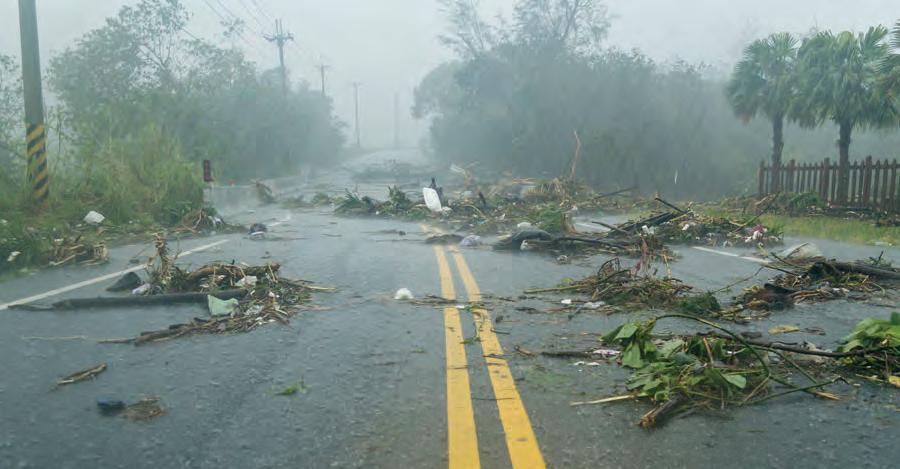
Tropical Storm Elsa was among those that affected North Carolina in 2021.
Above-Normal Hurricane Season Predicted
The Atlantic hurricane season began June 1 and runs through November, and this season is predicted to be busier than usual. The 2022 Atlantic hurricane season will see up to 21 named storms forming in the Atlantic basin, according to researchers at both NC State University and the National Oceanic and Atmospheric Administration (NOAA). The Atlantic basin includes the entire Atlantic Ocean, the Gulf of Mexico and the Caribbean Sea. The long-term average of named storms is 11.
Of the predicted named storms, seven to nine may grow strong enough to become hurricanes (the historical average is six), with the possibility of three to five storms becoming major hurricanes, according to NC State University.
Although no hurricanes made landfall in North Carolina in 2021, three tropical systems moving through the state — Claudette, Elsa and Fred — brought heavy rainfall, high winds and flooding. Hurricane Ida, which made landfall as a category 4 hurricane in Louisiana in September 2021, impacted communities as far north as New England.
“Hurricane Ida spanned nine states, demonstrating that anyone can be in the direct path of a hurricane and in danger from the remnants of a storm system,” said FEMA Administrator Deanne Criswell. “It’s important for everyone to understand their risk and take proactive steps to get ready now by visiting Ready.gov (Listo.gov en español) for preparedness tips, and by downloading the FEMA App to make sure you are receiving emergency alerts in real-time.”
Be Prepared For Whatever Mother Nature Brings
Whether storm clouds are on the horizon or a hurricane is in the forecast, NCStormCenter.coop is your one-stop-shop for important information to protect you and your family during severe weather. Resources include:
A real-time statewide outage map Information on what to do before, during and after a storm Specific resources for hurricanes, flooding, tornadoes and winter storms
EneryUnited’s Wayne Wilkins Retires After 51 Years of Service
Thomas Golden appointed as next CEO
In May, EnergyUnited CEO Wayne Wilkins retired following a career with electric co-ops that spans decades.
“Over the course of his storied career in the energy industry, Wayne was continually committed to supporting member and community service initiatives that positively impacted so many people,” said EnergyUnited Board Chairman and President Dr. Max Walser. “I am incredibly thankful to have had the opportunity to serve with Wayne and sincerely appreciate all that he has done on behalf of EnergyUnited members.”
Wilkins’ 51-year career with North Carolina’s electric cooperatives includes service as CEO of Davidson EMC, where he helped coordinate the consolidation of it and the neighboring Crescent EMC to form the present-day EnergyUnited, based in Statesville, in 1998. The co-op has since deployed new technologies to better serve members and increase reliability, including advanced metering infrastructure, smart grid technology and electric vehicle chargers.
His service to the electric cooperative network extends to the state level, where he served on the North Carolina Electric Membership Corporation and North Carolina Association of Electric Cooperatives (NCAEC) boards of directors, including providing guidance as NCAEC Board President in 1990 and serving on the NCAEC Executive Committee from 2008–2013. He has worked closely with legislators at the state and national levels, advocating on behalf of the communities served by electric cooperatives across North Carolina, and has supported political action as Chair of the Rural Electric Action Program.
“As I look back and ask myself the question of what I would do different, I don’t think I could’ve picked a better business to be in,” Wilkins told EnergyUnited members ahead of his retirement. “There are just so many incredible people and facets within this job that have pushed me and grown me as a leader, a friend and even a father.” Following the announcement of Wilkins’ retirement, EnergyUnited Board of Directors appointed Thomas Golden to serve as the cooperative’s next CEO.
Golden recently served at the co-op’s COO, where he was responsible for the oversight, implementation and execution of many strategic initiatives that focused on “There are just so developing growth opportunities, operational enhancemany incredible ments, improving member value and maintaining superior safety and reliability performance. He holds a Bachelor people and facets of Science degree in nuclear engineering and engineering within this job that physics from Rensselaer Polytechnic Institute in New York, as well as a Master of Business Administration from have pushed me Wake Forest University. “I am honored to serve EnergyUnited members as the and grown me as cooperative’s CEO,” Golden said. “More than 115,000 a leader, a friend EnergyUnited members trust their cooperative each day to deliver safe, affordable, reliable and environmenand even a father.” tally-responsible energy. While these primary service pillars remain consistent, our members’ expectations will continue to evolve with the implementation of new technologies and innovative solutions. As EnergyUnited’s CEO, I’m excited to lead the cooperative into this future with member satisfaction always top of mind.”
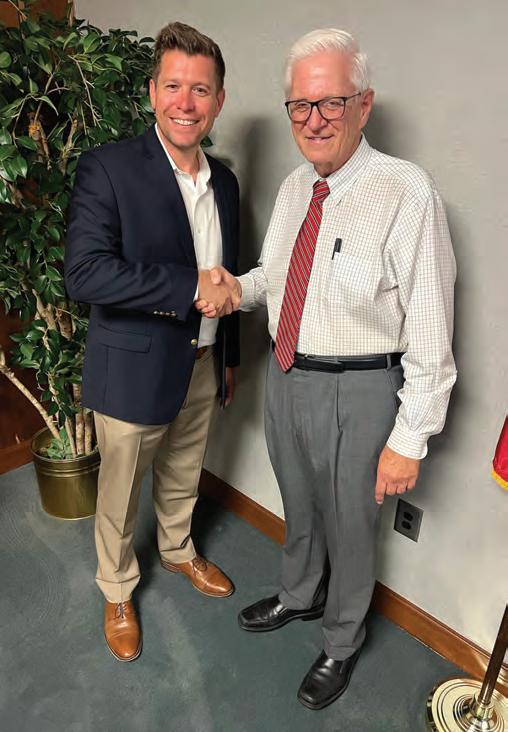
Thomas Golden (left) will serve as EnergyUnited’s next CEO. Retiree and prior CEO Wayne Wilkins spent 51 years working with North Carolina’s electric cooperatives.
VisitNC.com As the son of a commercial fisherman, Beaufort native Carl Cannon, Jr., came by his love of the sea honestly — though some people would say he took a wrong turn along the way. As an adult, Cannon chose a life of pirating. He’s commander of a rowdy band of swashbucklers, mermaids and sailors landing at Gallant’s Channel September 23–25 for this year’s Beaufort Pirate Invasion (beaufortpirateinvasion.com).
“Pirates have gotten a bad rep, but it really depends which side you’re on,” says Carl, who spends his days organizing pirate invasions and volunteering at the Maritime Museum in this seaside town, which is nestled between the outlying Shackleford and Bogue banks.
“Over history pirates are typically robbers and thieves,” Carl adds, then slipping into character: “We are privateers, hired by kings and the wealthy to protect their property from their enemies, and sometimes it’s necessary to appropriate their cargo. We’re the good guys.”
Pirate activity in and around Beaufort harks back to the Golden Age of Piracy, when the infamous Blackbeard ran the Queen Anne’s Revenge aground in Beaufort Inlet in 1718, and in 1747 when Spanish privateers attacked and plundered the small town until local militia finally drove the attackers away.
It was that bit of tumultuous history that inspired the first event in 1960: a reenactment of the invasion performed by the local fire department.
“When I was just a kid, my mom would take me to the original Pirate Invasions, which started here in the early 1960s,” Carl says. “I can remember waiting on the docks for my dad to come home between fishing trips, and when I was pretty young, I was given my first rowboat. So between those early days and our family’s history with the sea, I guess I always dreamed about that kind of life.”
Invasions through the years
Those early Pirate Invasion events of the ’60s were two-hour performances featuring pirate antics and a bit of history, but after several years, interest waned. America’s Bicentennial and the tall ship cruises revitalized it.
“Around that time, well-known pirate Captain Horatio Sinbad joined in the fun for several years, and he and his ship ‘Meka II’ brought a new aspect to the event for a time,” Carl says. “Then we underwent another revival in the 1980s. The pandemic slowed us down, but all in all, we’ve done 48 events since the early 1960s.”
Before Carl took up the pirate life, he was a commercial fisherman and worked on a dredge boat. By 2012, he had purchased and outfitted a sailboat into an 18th-century replica of a pirate ship and began pirating. In 2017, he took over volunteer leadership as president of the Beaufort Pirate Invasion. The festival became a non-profit in 2015 so that it could raise money for charity — last year, the group funded a violin and a cello for the classical music program at East Carteret County High School.


Samantha Taylor Samantha Taylor

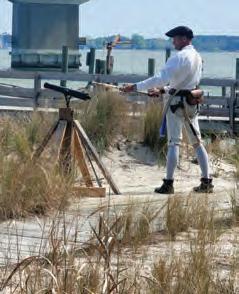
Samantha Taylor
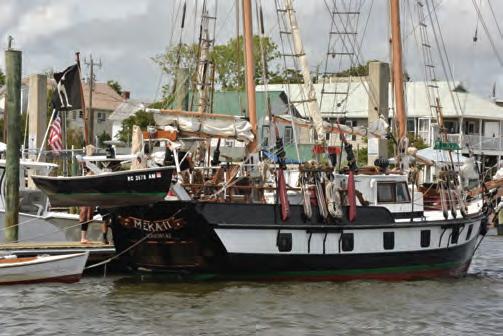
Darryl Marsh

Swansboro swashbuckling
In May, Carl’s crew descended on Swansboro in Onslow County for its two-day Pirate Fest.
“There were boats, encampments, cannon firings, sword fights and even a pirate scavenger hunt,” says LaQuesha Cadwallader, recreation program supervisor with Onslow Parks and Recreation, which presented the event with Swansboro Parks and Recreation. “People just really like pirates.”
Event attendees got into the action. “Many of the adults and kids came dressed up like pirates,” Director of Swansboro Parks and Recreation Anna Stanley says. “And the invasion on the water with the battle between the ships is amazing. It’s one of my favorite annual events here.”
Upcoming piracy
In September, Carl and his pirate crew of nearly 40 will sail into Gallants Channel and set up their encampment on its shores, living the pirate life throughout the three-day festival. Battles between pirate ships, living history displays and reenactments, sword fights, mermaids, lady pirates and black-powder demonstrations bring the past alive.
The Motley Tones, Thunder and Spice and The Crossjacks set a pirate-style musical backdrop for magicians, stilt walkers, the Creative Flame fire dancers, peg-legged buccaneers, blacksmiths and axe-throwers.
“It’s our mission to keep the tradition alive with our pirate invasion events up and down the Atlantic Coast, showcasing the fun and history of this oft-maligned lifestyle,” he says. “Once you get to know us, you’ll find that our pirate crews are a friendly bunch who only pick up a sword when necessary, fire our cannons to demonstrate our might — and are a lot more bark than bite.”
Carl Cannon, Jr. (right), with Michael Taylor (aka Brax) at a past event
Pamela A. Keene is a freelance journalist who writes for magazines and newspapers across the Southeast and nationally.

The storied lives of Anne Bonny and Mary Read

By Donna Campbell Smith
Carolina colonial history is full of stories of pirates, evil men who preyed on unarmed vessels along the Atlantic coast. Sometimes the line between honest seaman and pirate was a fuzzy one. Perhaps the fuzziest line of all was drawn in the case of two pirates who sailed under the black flag of “Calico Jack” Rackham, who countered the typical image of a pirate — not because of what side of the law they were on, but because of their gender. They were the lady pirates Anne Bonny and Mary Read.
This dastardly duo were among a very few female pirates in recorded history, and most of what we know about them is drawn from the 1724 book, “A General History of the Pyrates.”
Anne Bonny
Anne Cormac was born in Ireland in 1702, the illegitimate daughter of William Cormac and his servant, Mary Brennan.
Cormac later sailed with his lover and baby to America. They settled near what is now Charleston, South Carolina. When Anne was a teenager, her mother died. Anne became manager of their plantation. She had a hot temper; legend tells she beat a man nearly to death with a chair when he made unwanted advances.
Fed up with the genteel life of the colonial South, she married James Bonny, who was known to dabble in pirating. That is how Anne met the pirate Calico Jack. They became lovers, and she ran off to sea with him. Anne gave birth to Jack’s child while they were in Cuba. (It is believed they left the baby with friends and went back to sea.)
By now, Anne was a full-fledged member of the crew. She dressed in men’s clothing, probably at Jack’s request. She was handy with sword and pistol, and quick to use them.
Anne next fell for one of Jack’s crewmen. Although in a twist fit for a swashbuckling movie script, Anne soon learned that fellow crewman “Mark” Read was also a female disguised in men’s clothing.
Mary “Mark” Read
Mary Read (aka Mark), began life differently than Anne. Born in England, she was disguised as a boy from infancy. Her widowed mother pretended Mary was a boy to receive a death benefit not otherwise available to a girl child.
When Mary was older, Mrs. Read hired her daughter out as a footboy. It wasn’t long before Mary tired of that job and ran away. She took on a position with a British man-of-war and later joined the army as a soldier.
Mary, still believed to be a man by all, fell in love with a fellow soldier. They kept her gender a secret until after their time with the army, at which point they became publicly married. Mary and her husband lived a normal and happy life running a tavern.
Then, Mary’s husband died. She failed with the tavern business and returned to the life she knew best. Disguised as a man she joined an army in Holland. Later she took a position on board a ship sailing for the West Indies.
Pirates, led by Calico Jack, attacked the merchant ship, and Mary was taken prisoner. From that time on, Mary was a pirate.

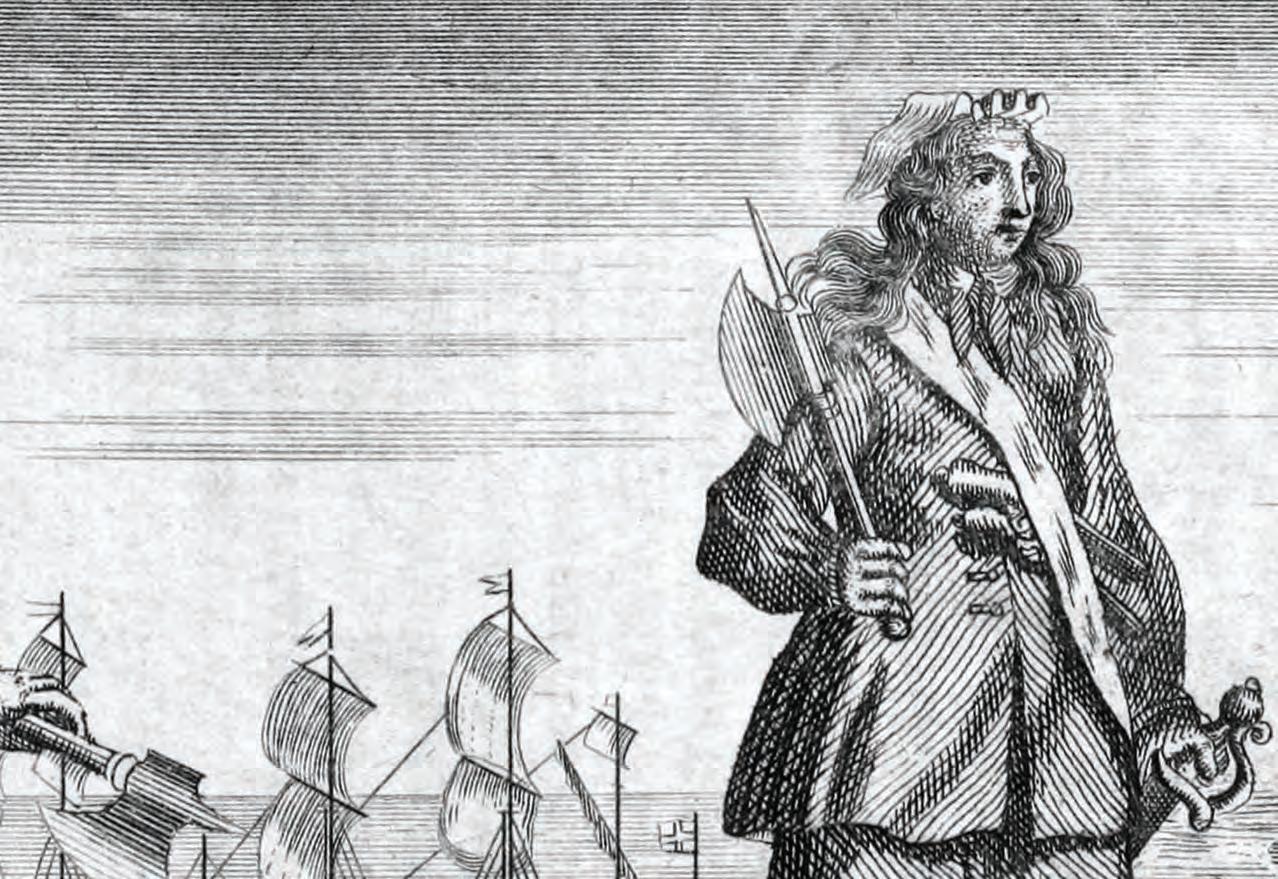
Divergent fates
It wasn’t long before Mary and Anne became aware that they were each a woman. Calico Jack, none the wiser at first, became jealous of “Mark” and threatened to slit his throat. Anne had to let him in on her and Mary’s secret.
But the drama didn’t end there. Mary had an affair with another crewman and became pregnant. Meanwhile, Calico Jack’s ship was captured, and the pirates were put on trial. The men were all sentenced to hang, with Jack scheduled to die the next day. He asked to see his beloved Anne before his execution, but if he’d hoped for sympathy, he got none. As Anne succinctly put it: “I am sorry to see you in this predicament, but had you fought like a man, you would not have to die like a dog.”
Mary and Anne were tried, however, both were pregnant at the time and since a pregnant woman could not receive the death penalty, their sentences were delayed.
Mary, however, died while in prison. Anne’s fate was unknown until the twentieth century, when a rumor surfaced that her name was found in a family Bible, along with a birth certificate and some letters. The birth certificate named a boy child, John Cormac Bonny, whose father was named as John Rackham.
If this rumor is true, it supports the theory that Anne’s father bought her pardon and sent her back to the Carolinas. Some believe Anne Bonny married a man named Joseph Burleigh, lived to a ripe old age and is buried in Virginia. But to this day, how Anne truly spent her later years remains a mystery.
Anne Bonny (left) and Mary Read
Strong storms. Stronger network.
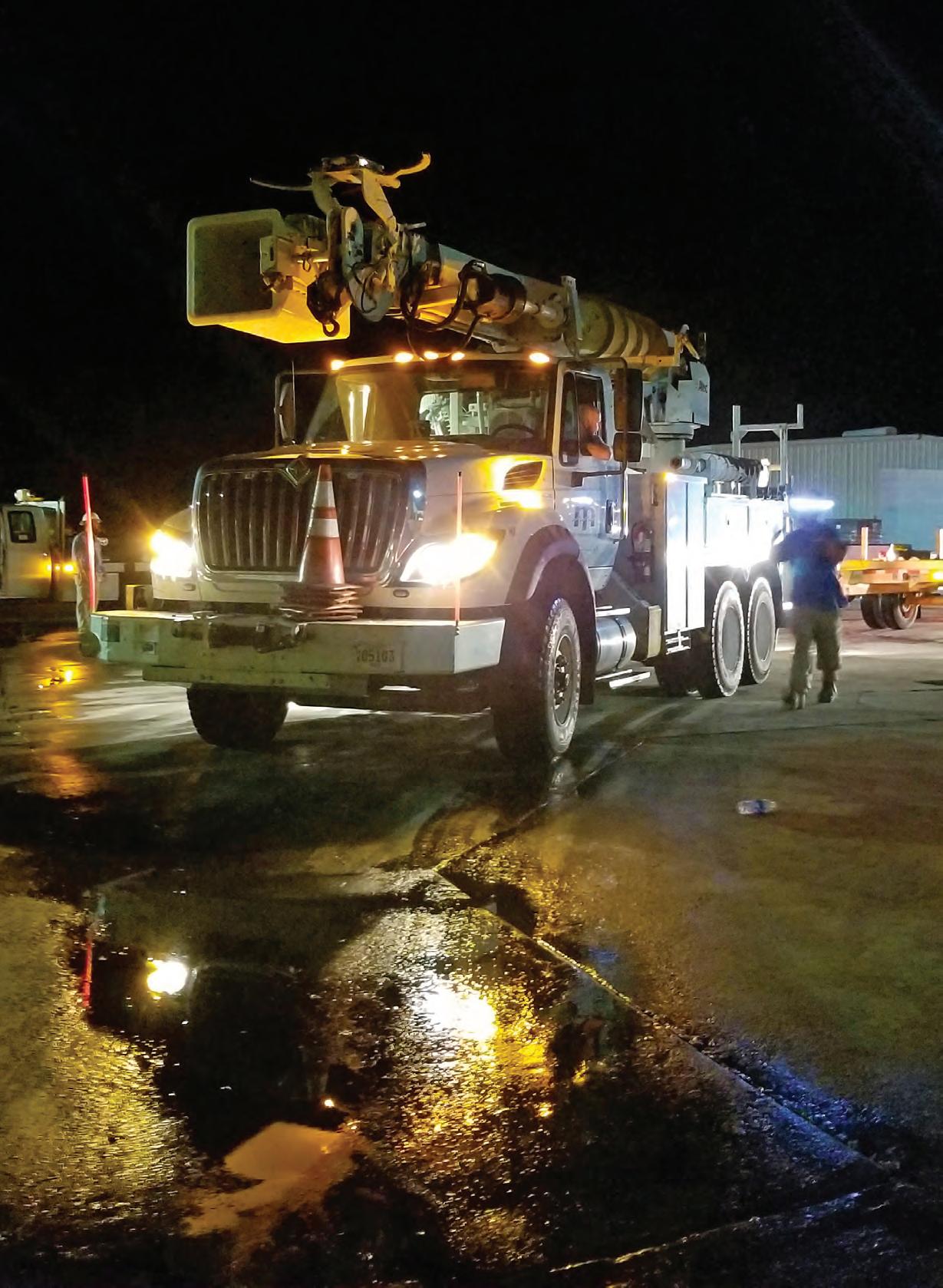
Co-op ingenuity and innovation are adding strength and flexibility to our grid. Coupled with the dedication of crews from home and afar, cooperatives are ready for whatever summer weather brings.
MEMBERNews

CARTERET-CRAVEN ELECTRIC COOPERATIVE
Powered by our members!
Customer Service-Dispatcher Jordan Berean
Utility scale battery storage added

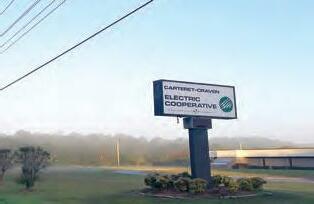
Celebrating our Independence
Carteret-Craven Electric Cooperative (CCEC) has installed cutting-edge battery energy storage technology in the co-op’s service territory. The battery project was integrated at the Maysville substation, adding local energy resources that will enhance system resilience and reliability for cooperative members.
“Carteret-Craven Electric Cooperative is committed to innovation that advances our Brighter Future vision for electricity that is affordable, reliable and supports our sustainability goal of net-zero carbon emissions by 2050,” said CEO and General Manager Jake Joplin. "This battery installation allows us to reduce demand costs and strengthen the grid."
The battery at the co-op's substation in Maysville is one of 10 substation batteries being deployed in rural locations this year by North Carolina’s Electric Cooperatives, including CCEC.
Collectively, the batteries will provide 40 megawatts of power, will be charged when demand for electricity is low and discharged during moments of peak demand for power. This not only enhances electric reliability but is expected to provide cost savings over the lifetime of the batteries. Because cooperatives are not-for-profit, at-cost energy providers, co-op members will benefit from those savings. In addition to substation batteries, CCEC and the network of cooperatives in North Carolina have worked together for years to lead innovative energy strategies, including community solar, microgrids, demand response programs and solar plus storage initiatives. “We will continue to lead the integration, management and optimization of resources and technologies that benefit our community and co-op members, now and in the decades to come,” said Joplin.
on the web Utility-scale FlexGen batteries provide energy We may have money storage supporting grid resilience and benefiting for you! Check our cooperative members. unclaimed capital credits list at: ccemc.com/CapitalCredits
Our offices will be closed Monday, July 4. We are available by phone at 252.247.3107 around the clock and online at ccemc.com. We wish you all a safe and happy holiday!
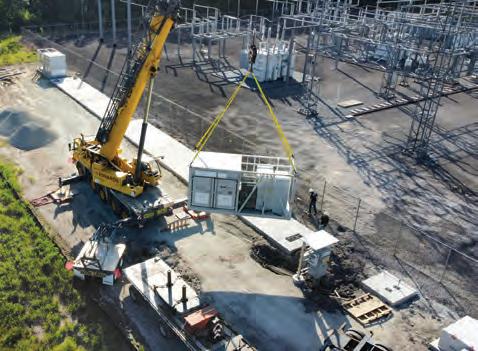
Carteret-Craven Electric Cooperative Restoring power safely and efficiently
We do our best to avoid them, but there’s no way around it: power outages occasionally happen.
For most Carteret-Craven Electric Cooperative (CCEC) members, outages are rare and only last a few minutes. In fact, last year CCEC had the lowest outage minutes ever recorded by the cooperative — only 34 minutes of outage time per member. We have set a new bar in reliability, but when major storms impact our area, extended outages are unavoidable.
So when the power goes out, how do CCEC crews know where to start working? How do you know if your outage has been reported? We’ve got answers to these questions and more, and it all starts with a safe, efficient plan for power restoration.
When the lights go out and it’s safe for our crews to begin the restoration process, they start by repairing power lines and equipment that will restore power to the greatest number of people in the shortest time possible.
This process typically begins with repairs to the larger main distribution lines that service a great number of homes and businesses. After those repairs are made, crews work on tap lines, which deliver power to transformers, either mounted on utility poles (for aboveground service) or placed on pads (for underground service). Finally, individual service lines that run between the transformer and the home are repaired.
We can’t control the weather, but we can prepare for it. CCEC keeps a supply of extra utility poles, transformers and other equipment on hand so we can quickly get to work in the event of an outage. When widespread outages occur, multiple crews will be out in the field simultaneously working to repair damage at multiple locations. We also coordinate with nearby co-ops to bring in additional crews when necessary.
A proactive approach to maintenance helps minimize the chance of prolonged outages; this is why you see CCEC crews and contractors periodically trimming trees and clearing vegetation near rights-of-way. We love trees too, but it only takes one overgrown limb to knock out power for an entire neighborhood. Trimming improves power reliability for our entire community. In addition to managing vegetation, we regularly inspect utility poles, power lines and other critical equipment to maintain a more reliable system.
Our substation monitoring system indicates when and where outages occur, and our automated metering infrastructure (AMI) system sends us a signal when power goes out at a meter.
Before reporting an outage, members should check our outage map (outage.carteretcraven.coop). Members should also sign up for outage texting. Text CCEMC to 1.800.682.2217. You will receive a text when the power at your service address goes out and when it is restored.
If you plan to use a generator for backup power, read all safety information and instructions before use. If you have a medical condition that requires electrical equipment, have a plan in place in the event of an extended outage. This plan could include a portable generator, extra medical supplies or moving to an alternate location until power is restored.
Mother Nature can be unpredictable, but as a CCEC member, you can feel confident knowing we’re standing by, ready to restore power as quickly and safely as possible.
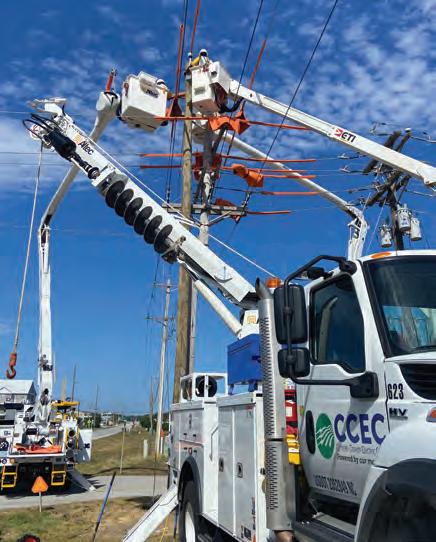
CCEC crews replace a pole in Emerald Isle that was damaged during Hurricane Isaias.

Send us your best shots!
We want to feature our members' best photos in our 2023 wall calendar. Submit high-quality digital photos depicting our area. The winning photographers will be entered in a drawing for a $100 gift card. Hurry! The deadline is Aug. 15. Visit ccemc.com/PhotoContest for more details.
As the old saying goes, "the early bird gets the worm.” Be one of the "early bird" K-12 teachers who submit their Bright Ideas Education Grant application by Aug. 15 and you'll have a chance to win a $100 Visa gift card.
The final deadline to apply for a Bright Ideas grant of up to $1,000 is Sept. 15.
The Bright Ideas Education Grant program, offered by CCEC and North Carolina's 26 electric cooperatives, advances excellence in education and accelerates student learning by providing funds for innovative classroom projects.
Since the program began in 1994, CCEC has awarded $572,000 in grants for 751 projects benefitting more than 143,400 students.
To learn more and apply, visit ncbrightideas.com.

Directors, new officers elected
CCEC Directors Ben Ball, Amy Lock and Thom Styron were re-elected to their terms during action taken by the board at its May 23 meeting.
When directors up for CCEC Board President re-election are unopposed, Anthony Nelson the board secretary will cast a single vote at the co-op’s annual meeting, or at the May meeting of the Board of Directors in the event of a virtual annual meeting.
The 2022 annual meeting was held virtually on May 5. Visit ccemc.com/AnnualMeeting to view the meeting.
The board also elected officers for 2022-23 at its May meeting. They are: president, Anthony Nelson; vice-president, Alvin West; secretary, Amy Lock; assistant secretary, Ben Ball; treasurer, Jim Schmitt; assistant treasurer, Thom Styron.
Solar energy questions and answers
Like any other major investment, installing a home solar system is a big decision. There is a lot to consider when determining if it's the right fit for you. As your local energy partner, we are here to help you make the best decision to suit your lifestyle and budget. Q: How do I know if solar is the right fit for me? A: There are many personal, financial and geographic considerations that should be assessed when considering home solar. One of the most important questions to ask early in the process is: What are my goals? If savings are your aim, you may find that energy efficiency measures can provide a faster return on your investment.
You'll need to determine if your location is favorable for solar generation. Consider the effectiveness of the insulation of your home, the age and efficiency of your HVAC system, the age and orientation of your roof, and tree coverage, among other factors. Q: How could solar impact my electric bill? A: Most solar arrays are designed to provide only a portion of the electricity needed and will not provide 100 percent of your needs.
Your home will still require electricity from the grid, which means you will continue to receive a monthly bill based on your energy use and a facilities charge. These facility charges cover the fixed cost of maintaining power poles and wires that connect your home to the grid. Q: Should I consider battery storage with my solar system?
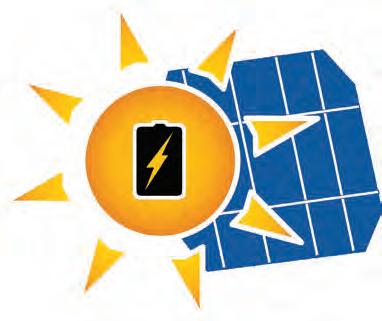
A: The cost of battery storage is significant and can cost nearly as much as installing solar on its own. When looking at storage for solar or as a stand-alone system, the decision really comes down to your goals and the cost to achieve those goals. Most people purchase battery storage for resilience and cost savings.
Because members who install solar are placed on our time-of-use rate, it is imperative that the battery storage system be programmed to discharge during time-of-use peak hours for maximum savings.
We encourage any member who is considering home solar to visit ccemc.com/renewables, where you can find information about how home solar panels are interconnected to the grid and factors to consider based on your goals.
Summer is here and so is the hot weather. Your heating, ventilating and air conditioning (HVAC) system is working overtime to keep your home cool and comfortable. Here are some simple tips for tackling the summer heat that will lower your energy usage and help keep your HVAC in good working order.
Ò Shift your use. Use major appliances like dishwashers, as well as washers and dryers, during early morning or late evening and overnight hours. These big appliances not only generate heat but also introduce moisture to your home, and that's an introduction you don't want to make during the hottest part of the day. Ò Keep kitchens cool. An indoor stove or oven can raise the temperature in your kitchen by as much as 5 to 10 degrees. Take advantage of an outdoor grill or indoor microwave or crock pot instead. Ò Turn it off. Lights, particularly incandescent lights, as well as common household appliances generate heat when they are on. Consider switching to more efficient LEDs, which generate much less heat. Unplug computers, gaming consoles and televisions when they are not in use. Ò Keep the sunshine out. Block light and heat by closing blinds, shades and curtains, especially on windows that get direct sun. Ò Clean the HVAC unit. Outdoor condenser coils can become clogged with pollen, dirt and small debris. Use a hose to spray the HVAC unit once each season to ensure maximum airflow. Ò Feel the breeze. Use portable fans and ceiling fans to chill out.
Make sure ceiling fans are running counter clockwise to push cool air down. Fans don't change the temperature of the room, but they can make you feel 3 to 4 degrees cooler.
Remember, fans cool people not rooms, so be sure to turn it off when you leave the room. Ò Introduce an open door policy. Keep the doors to rooms inside your home open so air can flow through naturally. Ò Replace and remove. Replace dirty air filters every month to increase the efficiency and air flow of your HVAC system. Remove furniture, rugs or other obstructions from your return registers to allow air to flow freely. Ò Clear space around the HVAC unit. Dryer vents, falling leaves and grass left behind from the lawn mower can create buildup. Remove any debris from around the
HVAC unit. If you have foliage near the unit, trim it back at least 2 feet from the condenser to increase airflow.
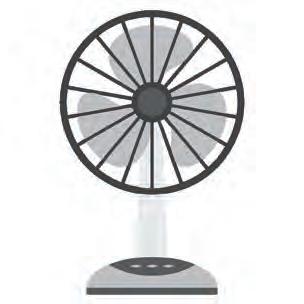
You probably don't notice the utility poles found throughout our service territory, but they are the backbone of our distribution network.
Strong, sturdy utility poles ensure a reliable electric system, which is why we routinely inspect the more than 32,000 poles found on our lines.
Throughout the year, our crews check poles for decay caused by exposure to the elements. Crews visually inspect the pole, dig around the base to look for rot and will sometimes take a bore sample.
Each power pole has a unique "birthmark" located several feet up the pole. It tells the species (tree type) of the pole and other information. After poles are put in service, they get a metal identification tag, each time they are inspected. Typically, a standard wooden pole is expected to last more than 50 years.
Equipment on each pole will vary based on location and the services provided in that area.
Never nail posters or other items to utility poles. Nails and tacks can snag boots or puncture protective clothing, putting lineworkers at risk of slipping or electrocution.
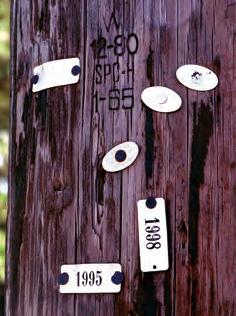
Offices
1300 Highway 24 Newport, NC 450 McCotter Blvd. Havelock, NC
Contact
252.247.3107 1.800.682.2217 ccemc.com customerservice@ccemc.com
Swimming in Savings

Help make your pool more energy efficient
By Jonathan Susser
Q: I read somewhere that my pool pump is one of the biggest energy users in my home. Is that true? What can I do to make it more energy efficient?
A: It is, indeed, true. Circulating, filtering and cleaning all that pool water yearround — especially in the summertime — eat up a significant amount of energy. In fact, pool pumps, due to their motor, may be your second largest energy consumer at home, behind only your heating and cooling system. Fortunately, there are efficient pumping technologies that will make less of a dent in your wallet while keeping the water crystal clear.
When evaluating a pool pump for efficiency and savings potential, the biggest thing to look for is whether it is single-speed or variable-speed. Single-speed pool pumps, as their name suggests, operate at only one speed no matter the task. In other words, they’ll run at the same rate when operating a chlorinator, supporting water features or filtering, despite the latter requiring less power.
Variable-speed pool pumps, on the other hand, can tailor their speed to specific uses, and can be programmed to do so, so that you don’t waste power when it isn’t necessary. These pumps also tend to be quieter and should require less maintenance and last longer than single-speed pumps, because slower filtration rates put less stress on the equipment. However, you’ll still want to properly maintain them just like the others — by repairing leaks and removing debris, for instance — so they operate at peak performance. A downside to variable-speed pool pumps is that they cost more upfront than single-speed pumps (though check with your electric cooperative for rebates). However, given their operating cost savings, their break-even point is typically just a couple of years, and you should save a substantial amount of money from then on — likely on the order of hundreds of dollars annually. Pool equipment manufacturer Pentair provides an online calculator (bit.ly/pool-calc) to gauge how much you might be able to save.
Also, keep an eye out for the Energy Star® label on pool pumps. Energy Star independently certifies variable-speed pumps — both in-ground and above-ground models — that meet specific criteria, so you’ll be even more confident that you’ll save energy and money. In fact, certified in-ground pool pumps use up to 65 percent less energy than standard pool pumps, and certified above-ground pool pumps use around 17 percent less energy.
While pumping will be your largest pool-related energy expense, there are additional ways to cut down on costs. For example, safely covering your pool when it’s not in use can help reduce any heating expenses, conserve water and even make cleaning easier. If you have a pool heater, try to avoid heating your pool too much beyond 78 degrees — each degree you add could set you back an additional 10% to 30% in energy.
So, worry a bit less about the bank and enjoy the sun and water this summer. Maybe you’ll even get to fit in a few extra pool parties with your new savings.








